Small overlap front: driver-side
Rating applies to 2007-15 models
Tested vehicle: 2014 Mazda CX-9 Touring 4-door 4wd
The Mazda CX-9 was introduced in the 2007 model year.
| Evaluation criteria | Rating |
|---|---|
| Structure and safety cage | |
| Driver injury measures | |
| Head/neck | |
| Chest | |
| Hip/thigh | |
| Lower leg/foot | |
| Driver restraints and dummy kinematics The dummy’s head barely contacted the frontal airbag before sliding off the left side as the steering column moved 33 cm to the right, resulting in little airbag cushioning for the chest. Additionally, the side curtain airbag did not deploy, allowing the head to hit the intruding driver door window frame and window sill. |
|
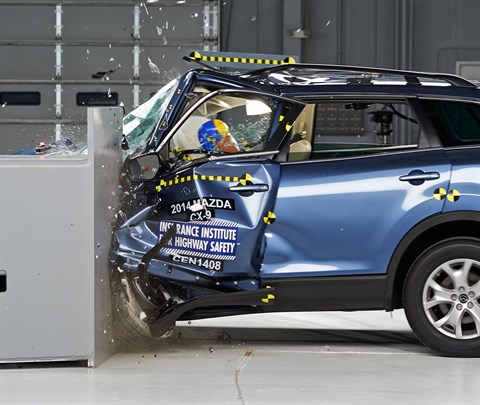
Action shot taken during the small overlap frontal crash test.

The dummy's position in relation to the door frame, steering wheel, and instrument panel after the crash test indicates that the driver's survival space was not maintained well.
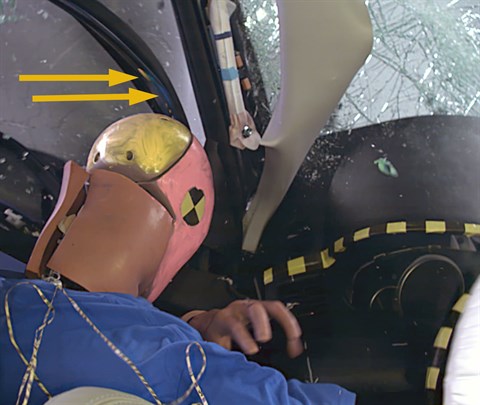
During the crash, the dummy's head and torso barely contacted the airbag before sliding off to the left as the steering column moved far to the right. Extensive intrusion and lack of a side curtain airbag deployment allowed the head to hit the door window frame, as indicated by smeared grease paint.
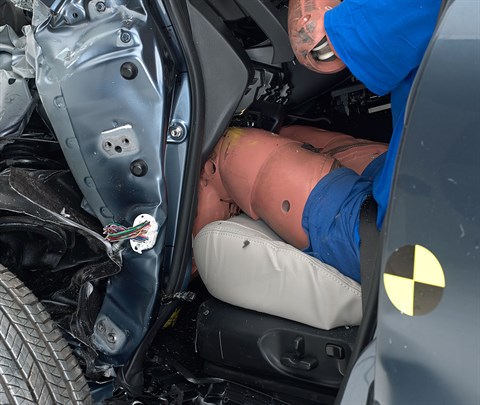
Door hinge pillar and instrument panel intrusion was extensive and contributed to a moderate risk of injury to the left knee.
Measures of occupant compartment intrusion on driver side
| Evaluation criteria | Measurement |
|---|---|
| Test ID | CEN1408 |
| Lower occupant compartment | |
| Lower hinge pillar max (cm) | 43 |
| Footrest (cm) | 19 |
| Left toepan (cm) | 15 |
| Brake pedal (cm) | 8 |
| Parking brake (cm) | 25 |
| Rocker panel lateral average (cm) | 6 |
| Upper occupant compartment | |
| Steering column | 12 |
| Upper hinge pillar max (cm) | 44 |
| Upper dash (cm) | 38 |
| Lower instrument panel (cm) | 33 |
Driver injury measures
| Evaluation criteria | Measurement |
|---|---|
| Test ID | CEN1408 |
| Head | |
| HIC-15 | 137 |
| Peak gs at hard contact | 96 |
| Neck | |
| Tension (kN) | 0.8 |
| Extension bending moment (Nm) | 7 |
| Maximum Nij | 0.28 |
| Chest maximum compression (mm) | 15 |
| Femur (kN) | |
| Left | 4.1 |
| Right | 1.5 |
| Knee displacement (mm) | |
| Left | 13 |
| Right | 5 |
| Knee-thigh-hip injury risk (%) | |
| Left | 1 |
| Right | 0 |
| Maximum tibia index | |
| Left | 0.68 |
| Right | 0.64 |
| Tibia axial force (kN) | |
| Left | 1.3 |
| Right | 0.0 |
| Foot acceleration (g) | |
| Left | 83 |
| Right | 35 |
Moderate overlap front: original test
Rating applies to 2007-15 models
Tested vehicle: 2008 Mazda CX-9 Grand Touring 4-door 4wd
The Mazda CX-9 was introduced in the 2007 model year.
| Evaluation criteria | Rating |
|---|---|
| Overall evaluation | |
| Structure and safety cage | |
| Driver injury measures | |
| Head/neck | |
| Chest | |
| Leg/foot, left | |
| Leg/foot, right | |
| Driver restraints and dummy kinematics | |
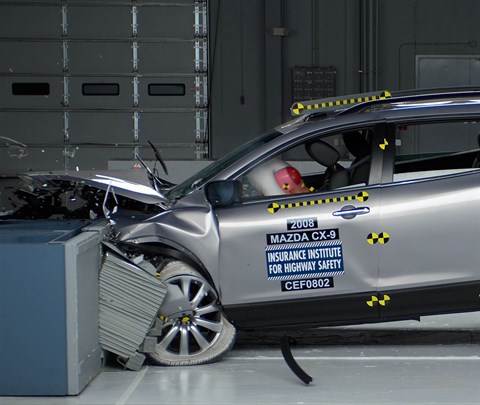
Action shot taken during the frontal offset crash test.

The dummy's position in relation to the steering wheel and instrument panel after the crash test indicates that the driver's survival space was maintained very well.
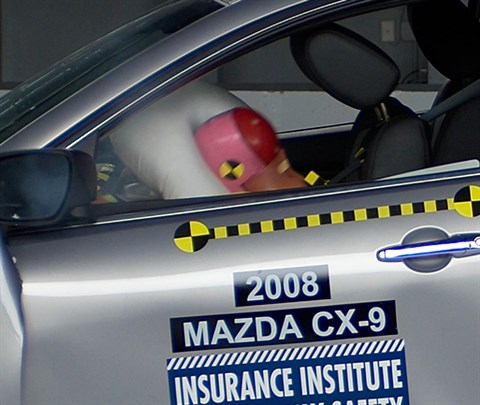
A high head acceleration occurred when the dummy's head hit the steering wheel through the airbag.
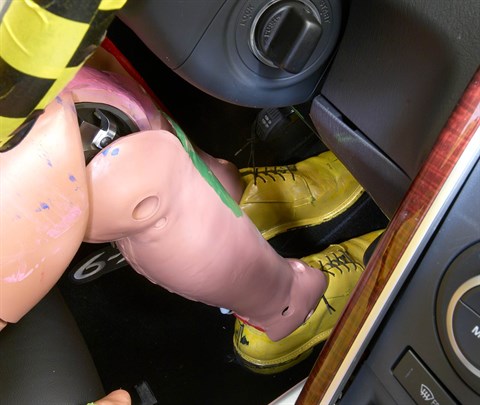
Forces on the lower right leg were high enough to indicate the possibility of injuries.
Measures of occupant compartment intrusion on driver side
| Evaluation criteria | Measurement |
|---|---|
| Test ID | CEF0802 |
| Footwell intrusion | |
| Footrest (cm) | 3 |
| Left (cm) | 2 |
| Center (cm) | 7 |
| Right (cm) | 7 |
| Brake pedal (cm) | 5 |
| Instrument panel rearward movement | |
| Left (cm) | -1 |
| Right (cm) | -1 |
| Steering column movement | |
| Upward (cm) | 1 |
| Rearward (cm) | -4 |
| A-pillar rearward movement (cm) | 0 |
Driver injury measures
| Evaluation criteria | Measurement |
|---|---|
| Test ID | CEF0802 |
| Head | |
| HIC-15 | 687 |
| Peak gs at hard contact | 98 |
| Neck | |
| Tension (kN) | 1.5 |
| Extension bending moment (Nm) | 27 |
| Maximum Nij | 0.42 |
| Chest maximum compression (mm) | 30 |
| Legs | |
| Femur force - left (kN) | 0.9 |
| Femur force - right (kN) | 2.3 |
| Knee displacement - left (mm) | 1 |
| Knee displacement - right (mm) | 0 |
| Maximum tibia index - left | 0.34 |
| Maximum tibia index - right | 0.89 |
| Tibia axial force - left (kN) | 1.9 |
| Tibia axial force - right (kN) | 4.6 |
| Foot acceleration (g) | |
| Left | 92 |
| Right | 104 |
Side: original test
Rating applies to 2007-15 models
Tested vehicle: 2008 Mazda CX-9 Grand Touring 4-door 4wd with standard head curtain airbags for all three rows of seats and standard front seat-mounted torso airbags
The Mazda CX-9 was introduced in the 2007 model year.
| Evaluation criteria | Rating |
|---|---|
| Overall evaluation | |
| Structure and safety cage | |
| Driver injury measures | |
| Head/neck | |
| Torso | |
| Pelvis/leg | |
| Driver head protection | |
| Rear passenger injury measures | |
| Head/neck | |
| Torso | |
| Pelvis/leg | |
| Rear passenger head protection | |
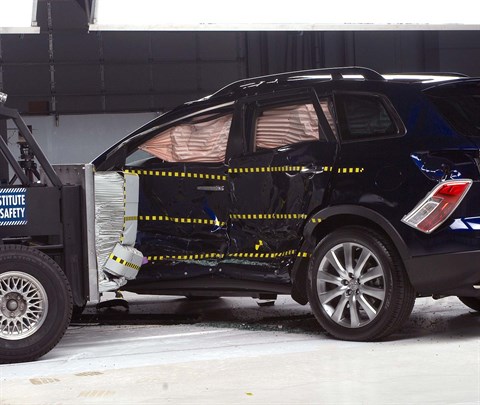
View of the vehicle and barrier just after the crash test.
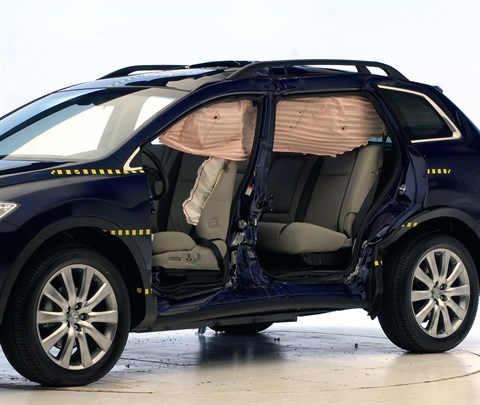
View of the vehicle after the crash with doors removed, showing the side airbags and damage to the occupant compartment.
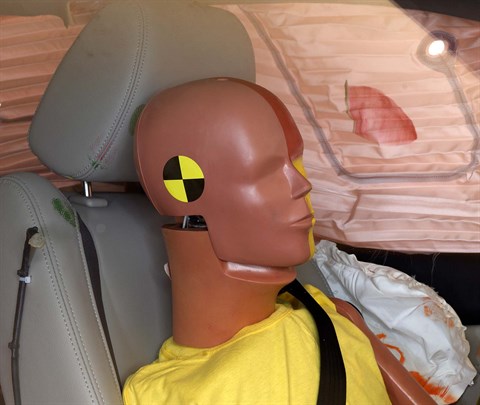
Smeared greasepaint shows where the driver dummy's head was protected from being hit by hard structures by the side curtain airbag.

Smeared greasepaint shows where the rear passenger dummy’s head was protected by the side airbag.
Measures of occupant compartment intrusion on driver side
| Test ID | CES0803 |
|---|---|
| B-pillar to longitudinal centerline of driver's seat (cm) | -11.0 |
| Negative numbers indicate the amount by which the crush stopped short of the seat centerline. | |
Driver injury measures
| Evaluation criteria | Measurement |
|---|---|
| Test ID | CES0803 |
| Head HIC-15 | 81 |
| Neck | |
| Tension (kN) | 0.8 |
| Compression (kN) | 0.0 |
| Shoulder | |
| Lateral deflection (mm) | 30 |
| Lateral force (kN) | 1.5 |
| Torso | |
| Maximum deflection (mm) | 23 |
| Average deflection (mm) | 21 |
| Maximum deflection rate (m/s) | 2.09 |
| Maximum viscous criterion (m/s) | 0.23 |
| Pelvis | |
| Iliac force (kN) | 1.5 |
| Acetabulum force (kN) | 2.6 |
| Combined force (kN) | 3.7 |
| Left femur | |
| L-M force (kN) | 0.8 |
| L-M moment (Nm) | 105 |
| A-P moment (Nm) | 45 |
Passenger injury measures
| Evaluation criteria | Measurement |
|---|---|
| Test ID | CES0803 |
| Head HIC-15 | 117 |
| Neck | |
| Tension (kN) | 0.2 |
| Compression (kN) | 0.4 |
| Shoulder | |
| Lateral deflection (mm) | 34 |
| Lateral force (kN) | 1.9 |
| Torso | |
| Maximum deflection (mm) | 31 |
| Average deflection (mm) | 24 |
| Maximum deflection rate (m/s) | 3.22 |
| Maximum viscous criterion (m/s) | 0.36 |
| Pelvis | |
| Iliac force (kN) | 0.8 |
| Acetabulum force (kN) | 3.0 |
| Combined force (kN) | 3.5 |
| Left femur | |
| L-M force (kN) | 0.5 |
| L-M moment (Nm) | 81 |
| A-P moment (Nm) | -27 |
Roof strength
Rating applies to 2010-15 models built after June 2010
Tested vehicle: 2010 Mazda CX-9 Sport 4-door 4wd
| Overall evaluation | |
|---|---|
| Curb weight | 4,463 lbs |
| Peak force | 12,562 lbs |
| Strength-to-weight ratio | 2.81 |
Head restraints & seats
Seat type: Power leather seat (AHR)
| Overall evaluation | |
|---|---|
| Dynamic rating | |
| Seat/head restraint geometry |
| Seat type | Power leather seat (AHR) |
|---|---|
| Geometry | |
| Backset (mm) | 45 |
| Distance below top of head (mm) | 38 |
| Seat design parameters | |
| Pass/fail | Fail |
| Max T1 acceleration (g) | 11.1 |
| Head contact time (ms) | 92 |
| Force rating | 2 |
| Neck forces | |
| Max neck shear force (N) | 121 |
| Max neck tension (N) | 726 |
About the head restraint & seat test
Currently, IIHS tests apply only to front seats.
